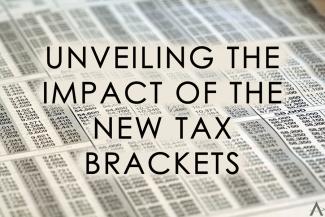
Navigating the Shifting Landscape of Taxes: Unveiling the Impact of the New Tax Brackets
In the ever-evolving world of finance, staying abreast of tax regulations is crucial for individuals and businesses alike. The recent adjustments to tax brackets, effective for the 2024 tax year, present an opportunity to reevaluate your financial strategies and ensure you're maximizing your tax benefits. We are here to work with your tax professionals to assist and guide you through the intricacies of these changes and help you understand their potential implications for your finances.
Firstly, let's delve into the specifics of the revised tax brackets. The thresholds for each income level have been adjusted upward to account for inflation, meaning that individuals will need to earn more to fall into higher tax brackets. For instance, the 10% tax rate, applicable to the lowest income bracket, now applies to taxable income up to $11,600 for single filers, an increase of $1,600 from 2023.
This upward shift in tax brackets translates to potential tax savings for a significant portion of taxpayers. For example, a single filer with taxable income of $30,000 would fall into the 12% tax bracket in 2023, but under the new brackets, they would remain in the 10% bracket, resulting in a tax reduction of $240.
However, it's important to note that the revised tax brackets are only one piece of the puzzle. Other factors, such as the standard deduction and dependent deductions, also play a role in determining your overall tax liability. The standard deduction, which represents the amount of income that is not subject to taxation, has also been adjusted upward for the 2024 tax year, providing further tax relief for many individuals.
Considering these changes, it's essential to review your financial plan to determine if any adjustments are needed. We will work with your tax advisor to understand your specific situation and identify potential opportunities to reduce your tax burden.
Here are some key considerations as you assess the impact of the new tax brackets:
- Evaluate your income level: Determine which tax bracket you fall into under the new guidelines and calculate the estimated tax savings or increase.
- Assess your deductions: Review the revised standard deduction and other applicable deductions to identify areas where you can maximize tax benefits.
- Consider tax-advantaged investments: Explore options such as retirement accounts or tax-exempt municipal bonds to further reduce your taxable income.
- Plan for the future: Anticipate potential changes in your income level and family situation to ensure your financial plan remains adaptable.
- Seek professional guidance: Consult with a qualified tax advisor to gain personalized insights and optimize your tax strategies.
Remember, the new tax brackets present an opportunity to enhance your financial well-being. By understanding the implications of these changes and making informed decisions, you can navigate the complexities of tax regulations and achieve your financial goals.
We appreciate the opportunity to assist you with your financial needs. As always, please feel free to call anytime.

